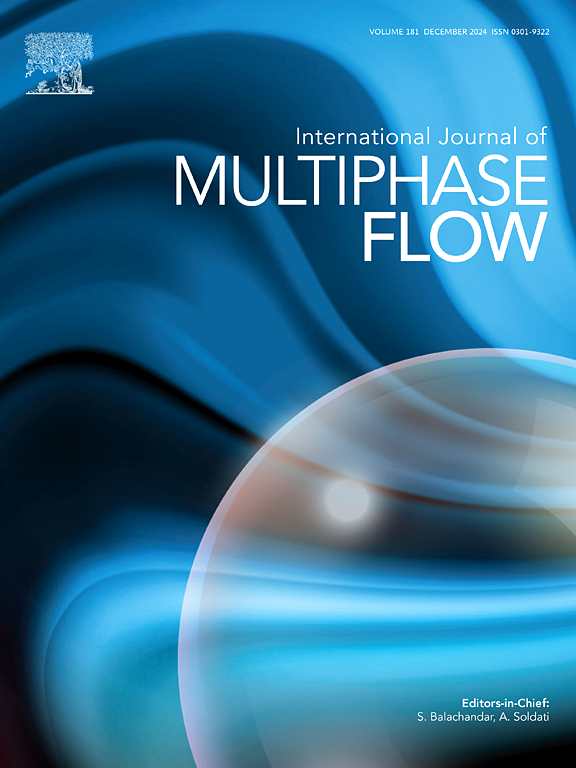持续均匀各向同性湍流中外强迫方案对液-液弥散的影响
IF 3.8
2区 工程技术
Q1 MECHANICS
International Journal of Multiphase Flow
Pub Date : 2025-10-03
DOI:10.1016/j.ijmultiphaseflow.2025.105469
引用次数: 0
摘要
我们提出了一个数值研究持续(强迫)均匀各向同性湍流(HIT)和液-液分散(两相流)之间的相互作用。采用弥散界面自由能晶格玻尔兹曼法对两相强制碰撞碰撞进行了直接数值模拟。所获得的单相热管的泰勒雷诺数范围为24.4-181。通过对受外力维持的两相流进行统计分析,评估了液-液分散的影响。我们选择了三种不同的强迫方案来对比外强迫和液-液分散对HIT特性的影响。采用逐级分析的方法,研究了液-液分散对强压能量级联的影响。界面张力的存在改变了能量传递机制。界面张力在一定波数范围内表现出线性空间相干性,具有非线性的能量传递和能量耗散。此外,与大波数下的单相流相比,液-液分散增加了流场的各向同性。瞬时涡度场的流动显示表明,两相流场比单相流场更集中,涡度区更强。我们还评估了液-液分散对涡度随应变速率排列的影响。我们研究中提出的见解对于进一步理解两相热流的能量传递机制以及产生和维持湍流的不同强迫方案对该机制的影响具有重要意义。本文章由计算机程序翻译,如有差异,请以英文原文为准。

Effect of external forcing scheme on liquid–liquid dispersion in sustained homogeneous isotropic turbulence
We present a numerical study investigating the interaction between sustained (forced) homogeneous isotropic turbulence (HIT) and a liquid–liquid dispersion (two-phase flow). The direct numerical simulations of two-phase forced HIT are performed using the diffuse interface free energy lattice Boltzmann method. The range of Taylor’s Reynolds number for the single-phase HIT achieved is 24.4–181. The influence of liquid–liquid dispersion is assessed by performing a statistical analysis of the two-phase flow sustained by external forcing. We selected three different forcing schemes to contrast the effects of external forcing and liquid–liquid dispersion on HIT characteristics. A scale-by-scale analysis was performed to study the role of liquid–liquid dispersion on the forced HIT energy cascade. The presence of an interfacial tension force modifies the energy transfer mechanism. The interfacial tension force exhibits linear spatial coherence with nonlinear energy transfer and energy dissipation in a specific range of wavenumbers. Furthermore, the liquid–liquid dispersion increases the isotropy of the flow field compared to the single-phase flow at large wavenumbers. Flow visualization of the instantaneous vorticity field indicates that the flow domain in the two-phase is more concentrated with intense vorticity regions than its single-phase counterparts. We also evaluated the effects of the liquid–liquid dispersion on the alignment of vorticity with the strain rate. The insights presented in our study are important for further understanding the energy transfer mechanism in two-phase HIT and the implications of different forcing schemes to generate and sustain turbulence on this mechanism.
求助全文
通过发布文献求助,成功后即可免费获取论文全文。
去求助
来源期刊
CiteScore
7.30
自引率
10.50%
发文量
244
审稿时长
4 months
期刊介绍:
The International Journal of Multiphase Flow publishes analytical, numerical and experimental articles of lasting interest. The scope of the journal includes all aspects of mass, momentum and energy exchange phenomena among different phases such as occur in disperse flows, gas–liquid and liquid–liquid flows, flows in porous media, boiling, granular flows and others.
The journal publishes full papers, brief communications and conference announcements.

 求助内容:
求助内容: 应助结果提醒方式:
应助结果提醒方式:


